Page 143 of 509
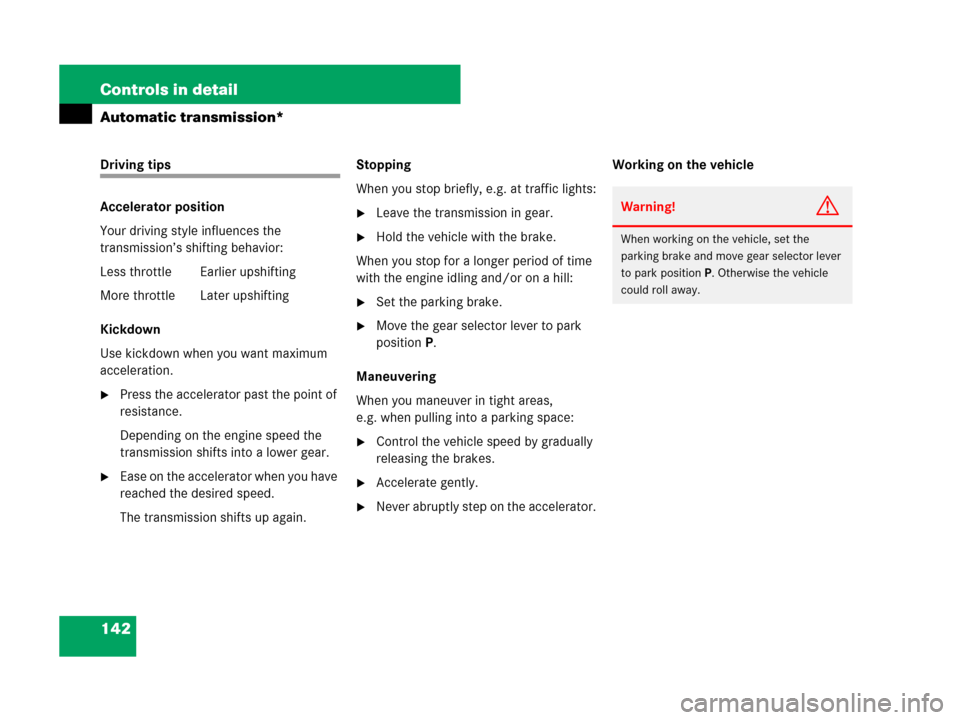
142 Controls in detail
Automatic transmission*
Driving tips
Accelerator position
Your driving style influences the
transmission’s shifting behavior:
Less throttle Earlier upshifting
More throttle Later upshifting
Kickdown
Use kickdown when you want maximum
acceleration.
�Press the accelerator past the point of
resistance.
Depending on the engine speed the
transmission shifts into a lower gear.
�Ease on the accelerator when you have
reached the desired speed.
The transmission shifts up again.Stopping
When you stop briefly, e.g. at traffic lights:
�Leave the transmission in gear.
�Hold the vehicle with the brake.
When you stop for a longer period of time
with the engine idling and/or on a hill:
�Set the parking brake.
�Move the gear selector lever to park
positionP.
Maneuvering
When you maneuver in tight areas,
e.g. when pulling into a parking space:
�Control the vehicle speed by gradually
releasing the brakes.
�Accelerate gently.
�Never abruptly step on the accelerator.Working on the vehicle
Warning!G
When working on the vehicle, set the
parking brake and move gear selector lever
to park positionP. Otherwise the vehicle
could roll away.
Page 146 of 509
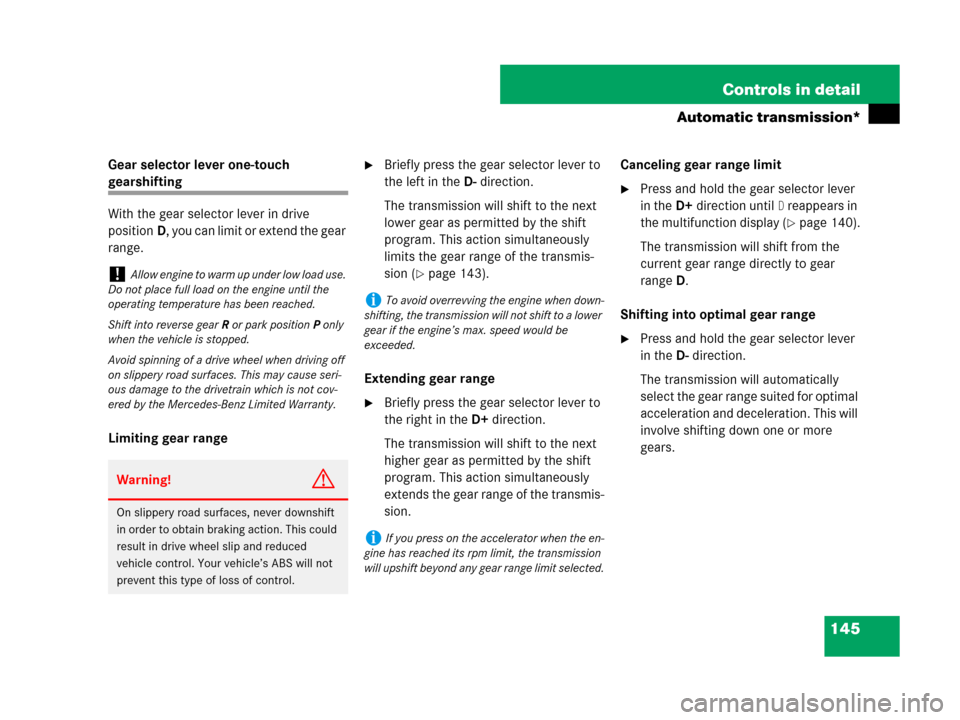
145 Controls in detail
Automatic transmission*
Gear selector lever one-touch
gearshifting
With the gear selector lever in drive
positionD, you can limit or extend the gear
range.
Limiting gear range
�Briefly press the gear selector lever to
the left in theD-direction.
The transmission will shift to the next
lower gear as permitted by the shift
program. This action simultaneously
limits the gear range of the transmis-
sion (
�page 143).
Extending gear range
�Briefly press the gear selector lever to
the right in theD+direction.
The transmission will shift to the next
higher gear as permitted by the shift
program. This action simultaneously
extends the gear range of the transmis-
sion.Canceling gear range limit
�Press and hold the gear selector lever
in theD+direction until
D reappears in
the multifunction display (
�page 140).
The transmission will shift from the
current gear range directly to gear
rangeD.
Shifting into optimal gear range
�Press and hold the gear selector lever
in theD-direction.
The transmission will automatically
select the gear range suited for optimal
acceleration and deceleration. This will
involve shifting down one or more
gears.
!Allow engine to warm up under low load use.
Do not place full load on the engine until the
operating temperature has been reached.
Shift into reverse gearR or park positionP only
when the vehicle is stopped.
Avoid spinning of a drive wheel when driving off
on slippery road surfaces. This may cause seri-
ous damage to the drivetrain which is not cov-
ered by the Mercedes-Benz Limited Warranty.
Warning!G
On slippery road surfaces, never downshift
in order to obtain braking action. This could
result in drive wheel slip and reduced
vehicle control. Your vehicle’s ABS will not
prevent this type of loss of control.
iTo avoid overrevving the engine when down-
shifting, the transmission will not shift to a lower
gear if the engine’s max. speed would be
exceeded.
iIf you press on the accelerator when the en-
gine has reached its rpm limit, the transmission
will upshift beyond any gear range limit selected.
Page 148 of 509
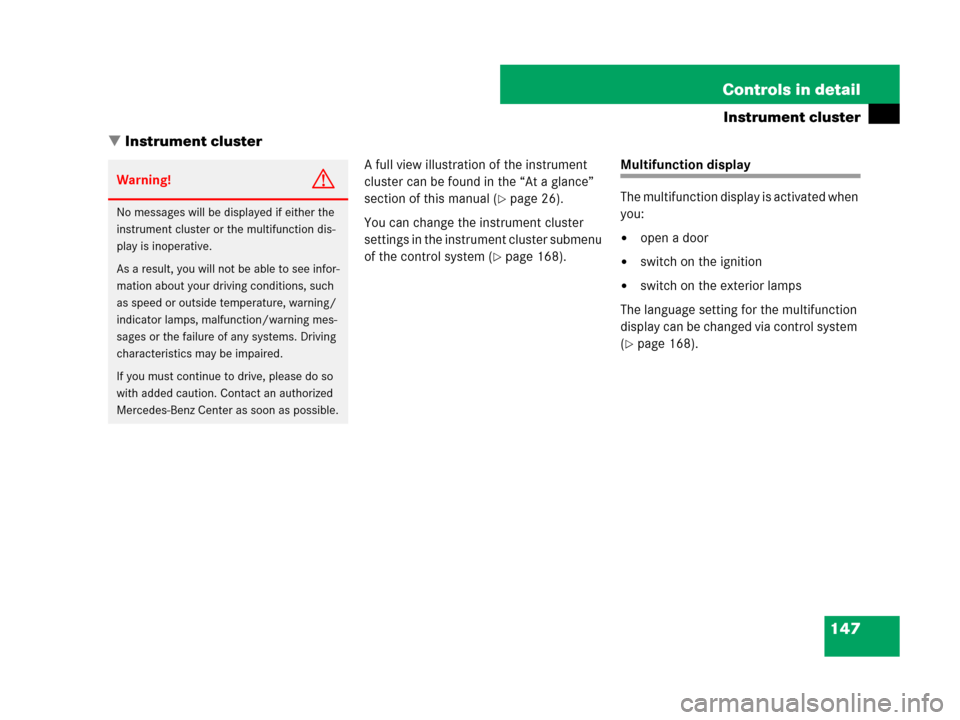
147 Controls in detail
Instrument cluster
�Instrument cluster
A full view illustration of the instrument
cluster can be found in the “At a glance”
section of this manual (
�page 26).
You can change the instrument cluster
settings in the instrument cluster submenu
of the control system (
�page 168).
Multifunction display
The multifunction display is activated when
you:
�open a door
�switch on the ignition
�switch on the exterior lamps
The language setting for the multifunction
display can be changed via control system
(
�page 168).
Warning!G
No messages will be displayed if either the
instrument cluster or the multifunction dis-
play is inoperative.
As a result, you will not be able to see infor-
mation about your driving conditions, such
as speed or outside temperature, warning/
indicator lamps, malfunction/warning mes-
sages or the failure of any systems. Driving
characteristics may be impaired.
If you must continue to drive, please do so
with added caution. Contact an authorized
Mercedes-Benz Center as soon as possible.
Page 149 of 509
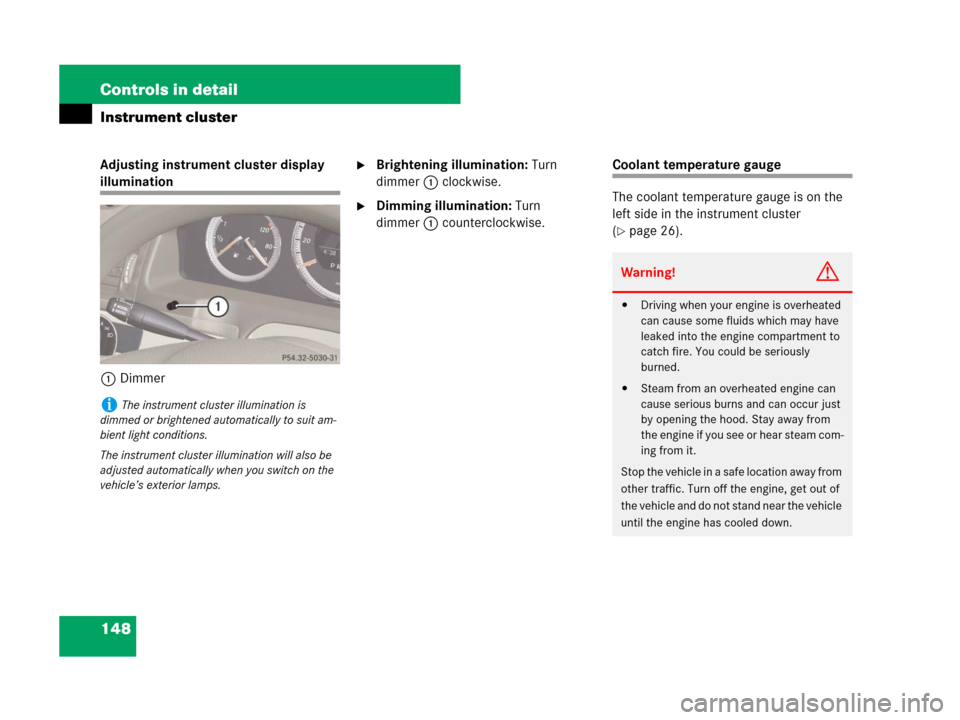
148 Controls in detail
Instrument cluster
Adjusting instrument cluster display
illumination
1Dimmer
�Brightening illumination: Turn
dimmer1 clockwise.
�Dimming illumination: Turn
dimmer1 counterclockwise.
Coolant temperature gauge
The coolant temperature gauge is on the
left side in the instrument cluster
(
�page 26).
iThe instrument cluster illumination is
dimmed or brightened automatically to suit am-
bient light conditions.
The instrument cluster illumination will also be
adjusted automatically when you switch on the
vehicle’s exterior lamps.
Warning!G
�Driving when your engine is overheated
can cause some fluids which may have
leaked into the engine compartment to
catch fire. You could be seriously
burned.
�Steam from an overheated engine can
cause serious burns and can occur just
by opening the hood. Stay away from
the engine if you see or hear steam com-
ing from it.
Stop the vehicle in a safe location away from
other traffic. Turn off the engine, get out of
the vehicle and do not stand near the vehicle
until the engine has cooled down.
Page 150 of 509
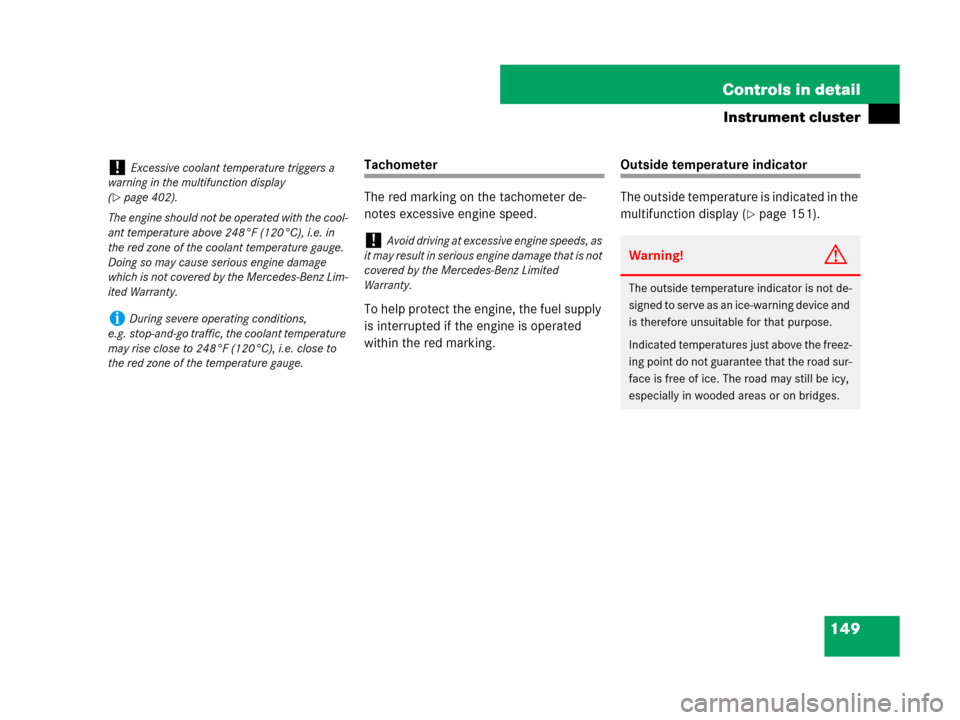
149 Controls in detail
Instrument cluster
Tachometer
The red marking on the tachometer de-
notes excessive engine speed.
To help protect the engine, the fuel supply
is interrupted if the engine is operated
within the red marking.Outside temperature indicator
The outside temperature is indicated in the
multifunction display (
�page 151).
!Excessive coolant temperature triggers a
warning in the multifunction display
(
�page 402).
The engine should not be operated with the cool-
ant temperature above 248°F (120°C), i.e. in
the red zone of the coolant temperature gauge.
Doing so may cause serious engine damage
which is not covered by the Mercedes-Benz Lim-
ited Warranty.
iDuring severe operating conditions,
e.g. stop-and-go traffic, the coolant temperature
may rise close to 248°F (120°C), i.e. close to
the red zone of the temperature gauge.
!Avoid driving at excessive engine speeds, as
it may result in serious engine damage that is not
covered by the Mercedes-Benz Limited
Warranty.
Warning!G
The outside temperature indicator is not de-
signed to serve as an ice-warning device and
is therefore unsuitable for that purpose.
Indicated temperatures just above the freez-
ing point do not guarantee that the road sur-
face is free of ice. The road may still be icy,
especially in wooded areas or on bridges.
Page 151 of 509
150 Controls in detail
Instrument cluster
The outside temperature sensor is located
in the front bumper area. Due to its loca-
tion, the sensor can be affected by road or
engine heat during idling or slow driving.
Therefore, the accuracy of the displayed
temperature can only be verified by com-
parison to a thermometer placed next to
the sensor, not by comparison to external
displays (e.g. bank signs, etc.).
When moving the vehicle into colder ambi-
ent temperatures (e.g. when leaving your
garage), you will notice a delay before the
lower temperature is displayed.
A delay also occurs when ambient temper-
atures rise. This prevents inaccurate tem-
perature indications caused by heat
radiated from the engine during idling or
slow driving.Fuel gauge
The fuel gauge is on the left-hand side of
the instrument cluster (
�page 26). Once
the fuel level has fallen below the reserve
mark, the yellow fuel tank reserve warning
lamp 4 for the fuel reserve comes on
(
�page 380).
Page 152 of 509

151 Controls in detail
Control system
�Control system
The control system is activated as soon as
the SmartKey in the starter switch is
turned to position2 or as soon as the
KEYLESS-GO* start/stop button (Canada
only) is in position 2. The control system
enables you to:
�call up information about your vehicle
�change vehicle settings
For example, you can use the control
system to find out when your vehicle is
next due for service, to call up statistical
data on your vehicle, and much more.
The control system relays information to
the multifunction display.
Multifunction display
1Text field
2Line for main menus
3Temperature
4Current program mode
(automatic transmission*)
5Current gear selector lever
position/gear range
(automatic transmission*)
Additional speedometer
(manual transmission)
6Digital clock
Settings, functions, submenus as well as
any malfunctions are shown to you in the
text field.
Warning!G
A driver’s attention to the road and traffic
conditions must always be his/her primary
focus when driving.
For your safety and the safety of others,
selecting features through the multifunction
steering wheel should only be done by the
driver when traffic and road conditions
permit it to be done safely.
Bear in mind that at a speed of just 30 mph
(approximately 50 km/h), your vehicle is
covering a distance of 44 feet
(approximately 14 m) every second.
Page 154 of 509

153 Controls in detail
Control system
Depending on the selected menu
(
�page 155), pressing the buttons on the
multifunction steering wheel will alter what
is shown in the multifunction display.
The information available in the multifunc-
tion display is arranged in menus, each
containing a number of functions or sub-
menus.
The individual functions are then found
within the relevant menu (radio or CD op-
erations under
Audio, for example). These
functions serve to call up relevant informa-
tion or to customize the settings for your
vehicle.
In the
Settings menu, instead of functions
you will find a number of submenus for
calling up and changing settings. For
instructions on using these submenus, see
“Submenus in the Settings menu”
(
�page 166).
It is helpful to think of the menus, and the
functions within each menu, as being
arranged in a circular pattern.The number of menus available in the sys-
tem depends on which optional equipment
is installed in your vehicle.
Using the control system
�To select a menu:
Press button(or&.
�To select a submenu:
Press button%or$.
�To go to the next higher menu level:
Press buttonL.
�To select the standard display: Press
buttonL repeatedly until the stan-
dard display featuring the odometer
and speedometer appears.
or
�Press and hold buttonL until the
standard display featuring the odome-
ter and speedometer appears.
�To confirm selection:
Press button#.
�To confirm display message:
Press button# or L.
The control system saves certain dis-
play messages. Calling up display mes-
sages (
�page 164).
For information about warning and mal-
function messages appearing in the multi-
function display (
�page 387).
iThe headings used in the menus table are
designed to facilitate navigation within the sys-
tem and are not necessarily identical to those
shown in the control system displays.
The first function displayed in each menu will au-
tomatically show you which part of the system
you are in.